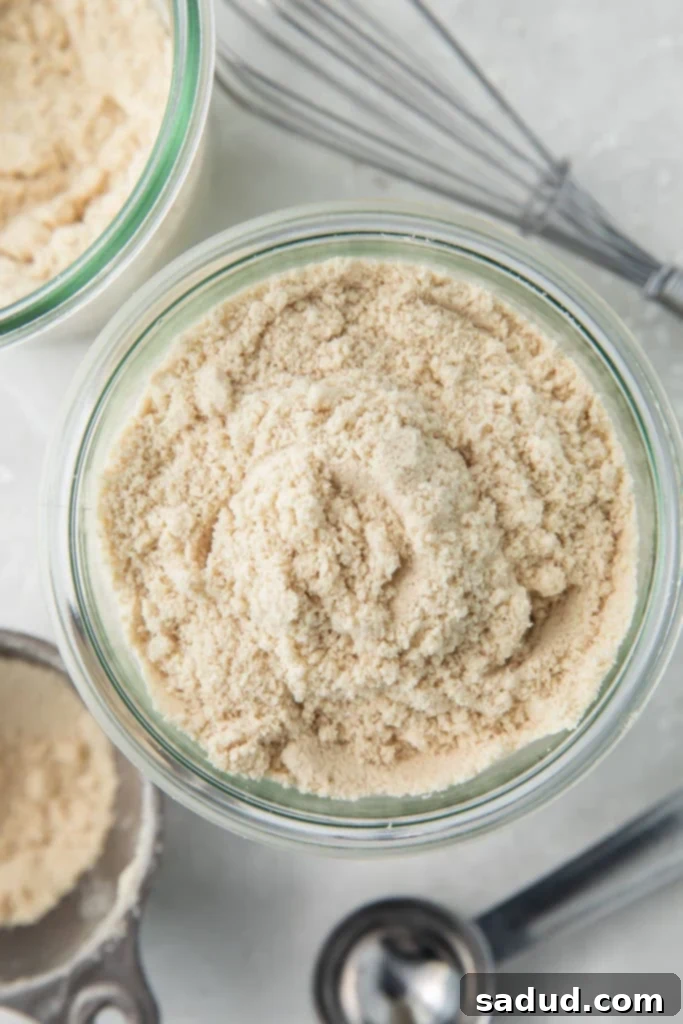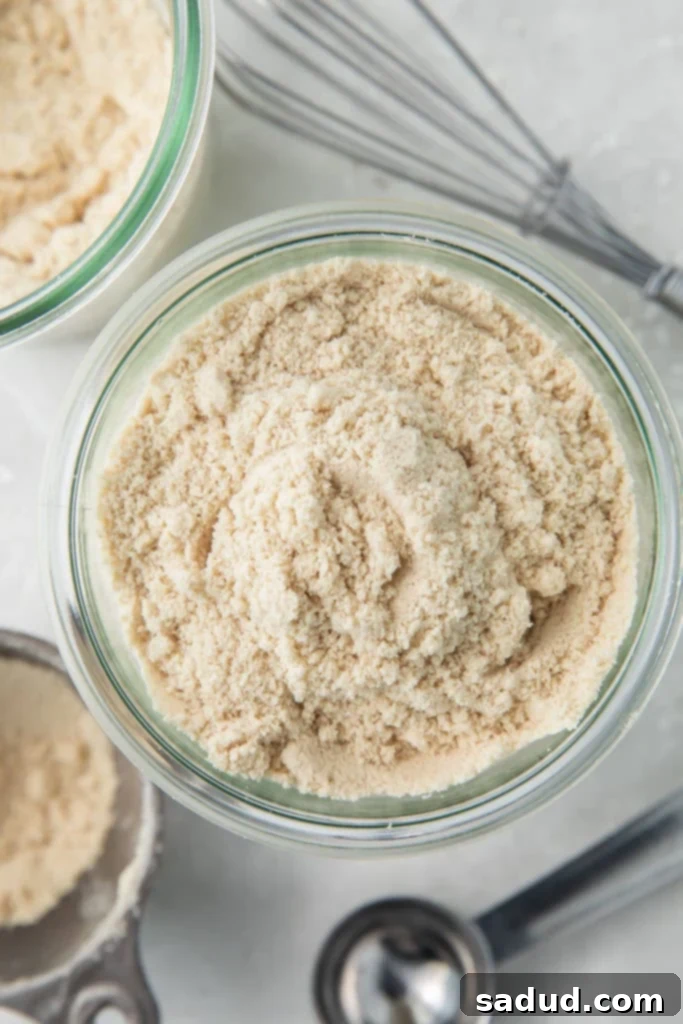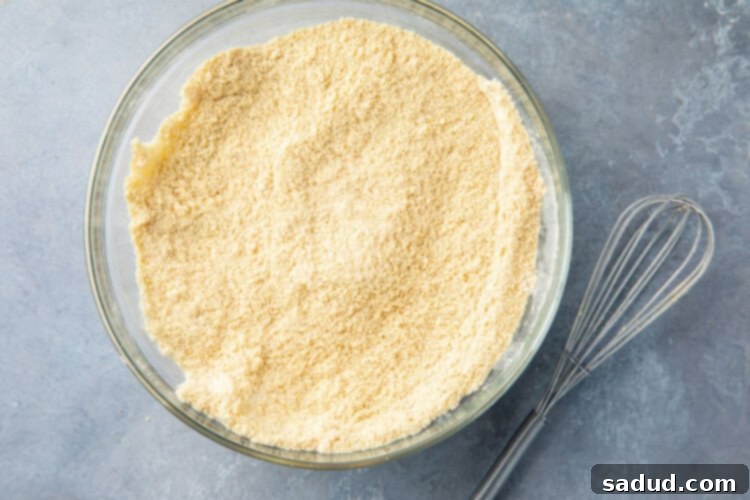The Ultimate Homemade Keto Flour Blend: Your Go-To Gluten-Free All-Purpose Mix for Perfect Low-Carb Baking
Embark on a culinary journey without the carb guilt with our meticulously crafted keto flour blend. This unique mix combines the ideal ratios of various gluten-free flour substitutes, offering an incredibly easy and convenient all-purpose solution for nearly any recipe you can imagine. Whether you’re a seasoned keto baker or just starting out, this versatile blend simplifies your low-carb lifestyle, making delicious, healthy baking more accessible than ever before. Say goodbye to dense, crumbly keto baked goods and hello to light, fluffy, and perfectly textured treats that truly rival their traditional counterparts.

Why This Homemade Keto Flour Blend Is a Game-Changer
Creating your own keto flour blend offers numerous advantages, transforming your low-carb baking experience. Our specific formulation is designed to address common challenges faced with single-ingredient keto flours, resulting in a superior, all-purpose alternative that performs beautifully across a wide range of recipes.
- Economical and Efficient: This blend utilizes small, precise amounts of a few different ingredients. This intelligent ratio ensures that each individual component goes further, making your investment last longer and maximizing your savings. It’s truly more bang for your buck compared to buying specialized pre-made mixes or using large quantities of expensive single flours.
- Achieving Perfect Texture and Consistency: On its own, almond flour can often result in dense, heavy baked goods, while coconut flour, known for its intense absorbency, can lead to dry and crumbly textures. Our blend masterfully combines these two, along with a couple of other key ingredients, to create a perfect all-purpose mix that skillfully mimics the texture and behavior of traditional wheat flour. This balance allows for optimal moisture retention and a delightful crumb structure, essential for successful low-carb baking.
- Baking Excellence with No Coconut Flavor: A common concern with coconut flour is its distinct flavor. However, when used in this blend, the coconut flour primarily contributes to keeping your baked goods incredibly fluffy and light, without imparting any noticeable coconut taste. This makes it ideal for a variety of sweet and savory recipes where a neutral flour base is desired, from delicate cakes to hearty breads.
- Seamless Substitution for Traditional Flour: For most recipes, you’ll find that this versatile blend can be swapped in at a convenient 1-to-1 ratio. This takes the guesswork out of converting traditional recipes to keto-friendly versions. While this is a general guideline, depending on the specific recipe, you might occasionally need to use slightly more or less of this blend, or adjust the liquid components in your recipe. We encourage you to experiment and discover the perfect balance for your favorite creations – don’t be afraid to get creative! This flexibility is part of what makes a homemade blend so empowering.
- Control Over Ingredients: By blending your own flour, you gain complete control over the quality and types of ingredients used. This means no hidden sugars, unwanted fillers, or artificial additives often found in commercial gluten-free or keto flour products. You know exactly what’s going into your food, ensuring a cleaner and healthier option for your dietary needs.
Decoding the Core Ingredients
Each ingredient in this keto flour blend plays a crucial role in achieving its all-purpose functionality and desirable texture. Understanding their individual contributions will help you appreciate the magic of this mix and even inspire your own custom variations.
Almond Flour – As a cornerstone of most keto baking, almond flour provides a mild, slightly nutty flavor and a good source of healthy fats and protein. It’s naturally low in carbs and gluten-free, making it an excellent base. However, its density can make baked goods heavy if used alone, which is why we combine it with lighter flours for balance.
Coconut Flour – Don’t let its high absorbency intimidate you; coconut flour is a superhero in low-carb baking. Made from dried, defatted coconut meat, it’s incredibly rich in fiber and very low in net carbs. Its unique ability to soak up a lot of moisture helps create structure and lightness in baked goods, preventing them from being too dense or gummy. In our blend, it contributes fluffiness without overpowering with coconut flavor.
Oat Fiber – This is a mild-tasting, incredibly fine powder produced by grinding the hull (or shell) of oats. Crucially, it’s virtually calorie-free and carb-free, composed almost entirely of insoluble fiber. It’s fantastic for adding bulk and structure to baked goods without contributing net carbs, which is super important on a ketogenic diet. Unlike oat flour, oat fiber does not contain the inner part of the oat grain, making it distinctively keto-friendly. Ensure you choose a brand certified gluten-free if you have celiac disease, as cross-contamination can occur during processing.
Xanthan Gum – Often referred to as the “secret weapon” in gluten-free and keto baking, xanthan gum acts as the primary binding and thickening agent in this keto flour blend. Since the other ingredients are naturally gluten-free, they lack the elasticity and binding power that gluten provides in traditional wheat flour. Xanthan gum steps in to provide that crucial elasticity, improving the texture, preventing crumbling, and adding a much-needed chewiness to your baked goods. A little goes a long way, so precise measurement is key for optimal results.

Expert Baker’s Tips for Your Keto Flour Blend
Mastering your homemade keto flour blend opens up a world of possibilities. Here are some expert tips to help you get the most out of your mix and achieve baking perfection every time:
- Customize to Your Liking: The beauty of a homemade blend is its flexibility. You can absolutely swap ingredients or adjust the quantities to discover the blend that best suits your personal preferences and specific dietary needs. For example, a small amount of psyllium husk powder can be added for extra chewiness in bread-like recipes, or you could experiment with a different nut flour if you have allergies. Just remember that any significant adjustments will alter the final characteristics and macro profile of your keto flour mix compared to our foundational recipe. Small changes can have big impacts in keto baking, so adjust gradually!
- Mind Your Macros – Brand Consistency Matters: The nutritional macros will naturally fluctuate based on the specific brands of ingredients you choose to use. Different brands of almond flour or oat fiber can have slightly varying carb counts due to processing or source. As a general rule for strict keto, always prioritize brands with the lowest possible net carb count. That being said, don’t be afraid to find your personal sweet spot. You may discover that you absolutely love the texture or flavor profile offered by a certain brand, even if it adds a carb or two more per serving than a less preferred brand. Ultimately, enjoying your food and sticking to your diet is paramount, so a slight macro adjustment for superior taste or texture is often well worth it.
- Handle Coconut Flour with Care: As mentioned, coconut flour is incredibly absorbent. If you are experimenting with substitutions or creating your own blends, it’s crucial to keep your total amount of coconut flour relatively low. Too much can quickly dry out your baked goods, making them dense or crumbly. Always balance it with other, less absorbent flours like almond flour. When adapting recipes, be prepared to add extra liquid (water, unsweetened almond milk, or eggs) if you notice your batter becoming too thick.
- Optimal Storage for Freshness: To maintain the freshness and efficacy of your keto flour blend, store it in an airtight container in a cool, dark pantry. For extended shelf life, especially in warmer climates, consider storing it in the refrigerator or freezer. This helps prevent the natural oils in almond flour from going rancid and keeps the blend in prime condition for your baking adventures.
- Troubleshooting Common Baking Issues: If your keto baked goods turn out too dry, it’s often a sign that more liquid is needed or the coconut flour ratio is too high for that specific recipe. If they’re too crumbly, you might need a bit more binding agent like xanthan gum, or perhaps an extra egg. Conversely, if they’re too dense, you might have used too much liquid or not enough leavening, or even packed your flour too tightly. Keto baking is an art, and practice makes perfect!
Discover More Amazing Keto Recipes
Now that you have your essential keto flour blend ready, the possibilities for delicious low-carb meals and treats are endless! Explore these fantastic recipes from our collection and our sister sites:
- Keto Chocolate Pudding
- Keto Grilled Cheese
- Magic Keto Lasagna
- Keto Granola
- Keto Meat Pie
If you loved this recipe as much as we did, don’t forget to leave us a review below. ★ Follow Easy Healthy Recipes on Pinterest, Facebook, and Instagram, too!
For more delicious recipes and kitchen inspiration, visit our sister sites, 40 Aprons and Easy Cheap Recipes.

Keto Flour Mix
 Cheryl Malik
Cheryl Malik
Print
SaveSaved!
Ingredients
- 2 cups almond flour
- ⅓ cup coconut flour
- ⅓ cup oat fiber see Notes for gluten free
- 1 teaspoon xanthan gum
Instructions
-
In a large mixing bowl, combine the almond flour, coconut flour, oat fiber, and xanthan gum. Whisk all ingredients together thoroughly until they are uniformly combined and no lumps remain. This ensures even distribution of each component, which is critical for consistent baking results. Once mixed, transfer your homemade keto flour blend into an airtight container for storage.

Notes
- Oat fiber is generally considered naturally gluten-free. However, it’s vital to be cautious of potential cross-contamination during processing, especially for individuals with severe gluten sensitivities or celiac disease. Always verify that your chosen brand is certified gluten-free if this is a concern.
This recipe yields approximately 10 quarter-cup servings of the flour blend. However, the actual number of “servings” you’ll get from this mix will largely depend on the specific recipes you use it for and your desired portion sizes.
The nutritional information provided is calculated based on a quarter-cup serving of the prepared blend. Please note that the actual macros may vary slightly depending on the specific brands and types of ingredients you utilize. Always check your ingredient labels for the most accurate information.
Nutrition Information
The number of total servings shown for the flour blend is approximate. The actual number of servings you derive from this mix will ultimately depend on your preferred portion sizes and the specific recipes you choose to prepare.
Nutritional values provided are general guidelines only and reflect information for one serving using the listed ingredients; they do not include any optional ingredients you might add. Please be aware that actual macros may vary slightly depending on the specific brands and types of ingredients used in your blend.
To accurately determine the weight of one serving of your finished baked goods, prepare the recipe as instructed. Once cooled, weigh the entire finished recipe (excluding the weight of the container). Then, divide the total weight by your desired number of servings. The result will be the precise weight of a single serving.

